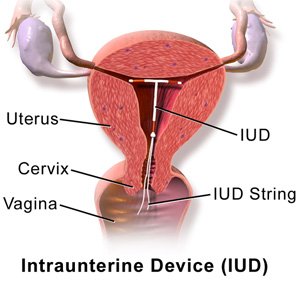IUD Contraceptive
 An Intrauterine device known as IUD for short, the IUD contraceptive is used to protect a woman from unwanted pregnancies. The IUD contraceptive is a small device usually made from copper and plastic. The IUD contraceptive will be placed into the uterus (womb), it used to be referred to as the coil or loop. The IUD is reversible but an excellent long term option of birth control. As always with most contraception it will protect against pregnancy but not against STD's.
An Intrauterine device known as IUD for short, the IUD contraceptive is used to protect a woman from unwanted pregnancies. The IUD contraceptive is a small device usually made from copper and plastic. The IUD contraceptive will be placed into the uterus (womb), it used to be referred to as the coil or loop. The IUD is reversible but an excellent long term option of birth control. As always with most contraception it will protect against pregnancy but not against STD's.
How does the IUD contraceptive work?
An Implant makes changes to the woman's body "which in turn" prevents the egg from being fertilized by the sperm. The IUD contraceptive achieves this by releasing copper into the body, this realize of copper changes the fluid in the fallopian tubes and the womb. In addition to this, the IUD contraceptive can also prevent the fertilized eggs from implanting in to the womb, and maybe used as emergency contraception. The IUD has to be fitted no later than five days after having unprotected sex in order to be effective. The IUD can sometimes be fitted five days after ovulation and still be effective as emergency contraceptive.
Types of IUD contraceptive
There are a number of choices and options to suit the woman, as well as different types there are a number of sizes available. There are two main types of IUD contraception the copper IUD and the mirena IUD. They are both small t-shaped object which inserted into the uterus, it is made from flexible plastic, there will be a piece of string which comes from the end of the IUD. This then can be used by the doctor it ensures it is in place also to aid removal.
Mirena IUD- releases a small amount of progestin levonorgestrel continuously, this can be left in for up to a 5-year period as a way to prevent pregnancy. The mirena IUD also prevents sperm from attaching to the egg this because the IUD affects how the sperm moves. Due to the hormone realise, the merina is thought to be more effective than the paragard IUD (copper IUD).
Paragard IUD-The t-shaped device wrapped in copper this works like the merina IUD, but rather than release hormones it realizes copper which acts like spermicide.
Norplant-This type of contraception is no longer available in the UK the controversial implant was thought to cause illness and serious side affects.
Having a IUD contraceptive fitted
A doctor will look at your medical history then thy can base there decision on which is the best contraception for the individual. Before a IUD is fitted a doctor or nurse will perform an internal examination, from this they can then determine the position and size of the womb. This is important for a IUD to work it needs to be positioned correctly. In some cases, a doctor may want to test for any STI's or infections, as its essential to be clear before having a IUD fitted. Fitting can take between 15-20 minutes the IUD will be inserted through the cervix into the womb. It can sometimes be painful and slightly uncomfortable especially if the cervix has not been stretched. For example, woman who already had children may not find it as painful.
After having a IUD contraceptive.
Occasionally it can cause bleeding for a few days afterward similar to menstrual bleeding, this is perfectly normal, and painkillers may be taken. The IUD contraceptive can stay fitted in place for anything up to ten years.
Who can have the IUD contraceptive?
Most woman will be able to have the IUD, woman who have never been pregnant or are HIV positive can have this. Womenare covered virtually from the moment it is fitted against UN wanted pregnancies.
Complications of having the IUD Contraceptive
There are certain things to consider when thinking of having a IUD contraceptive fitted, most complication arise within the first 12 months.
Pelvic Infections- For some woman, pelvic infections can happen in the first 20 days after it has been fitted. The risk of infection is relatively low less than 1 in 100 woman will get a pelvic infection caused by the IUD contraceptive. If any pain is experienced in the lower abdomen, even with or without a high temperature or discharge should be looked into by your doctor.
Rejection- This is where the womb rejects the IUD (expulsion) or it can move around and become displaced. Your doctor should show you how to check the IUD is still in place, this only usually happens soon after it has been fitted.
Perforation- once again this is only in rare cases a IUD contraceptive could go through the womb or the cervix (neck of the womb) when being inserted. If the doctor is experienced, there is an extreme low risk of this happening.
Ectopic Pregnancy- No contraceptive is 100%, and from time to time it can fail and you can become pregnant. There is a slight increased risk of having an ectopic pregnancy if a woman becomes pregnant whilst using the IUD contraceptive.
Periods- A possible side effect the IUD can cause are longer and heavy periods than before, but for most people, it eases of with in a couple of months. Heavy periods are more likely to occur if a woman has already been suffering with heavy periods. This is the most common reason woman will need to have there IUD contraceptive removed.
|